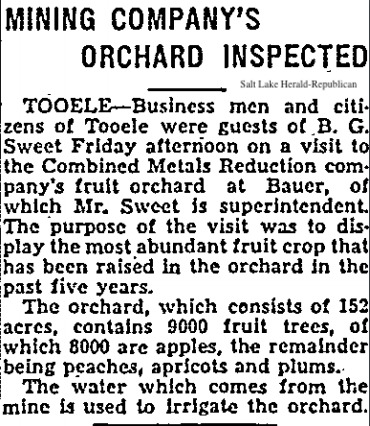Dublin Core
Title
Description
In 1933, a Tooele mining company called the Bullion Coalition gave away 700 bushels of their famous apples to low income families. But the story of how a mining company came to own a commercial orchard actually began much earlier, with the creation of one of Utah’s largest mine drainage tunnels.
After decades of mining in the Oquirrh Mountains, Tooele mines started to shut down in the early 1900s because vast reservoirs of groundwater blocked access to new ore deposits. The Honerine Tunnel was constructed in 1903 in an attempt to revive mining operations. It was seven feet wide, nine feet high, and 4,000 feet deep. A flume that ran below the car track allowed up to 2,000 gallons of water per minute to flow downhill from an underground reservoir.
With the groundwater drained, mining operations continued and the Bullion Coalition Company purchased the Honerine and all surrounding mines. The company’s founders Charles L. Crockwell and B. F. Bauer helped establish an orchard of fruit trees at the base of the mine in order to make use of the run-off water and retain rights to it. This water from deep in the Oquirrh Mountains made the Tooele Bauer orchard the largest in Utah and the only one owned by a mine. At its peak, the orchard covered 175 acres and grew 19,000 fruit trees – mostly apple, but also peach and apricot.
The arsenic, lead, and other heavy metals found naturally in the mine’s reservoir tainted the water used to irrigate the orchard, and likely poisoned the fruit. This was probably unknown at the time, since the orchard’s metalliferous fruit was “packed and shipped … to most of the large cities in the United States.” In the end, the orchard was abandoned as water was increasingly diverted for ore smelting operations instead. The industries of ore production and fruit growing in Utah may never again be paired in such a way – and that is probably for the best.
Creator
Source
_______________
See Don Strak, “Combined Metals Reduction Company,” UtahRails.net, accessed July 2020; “Pleasure Outing Held Sunday, June 20, at Saltair Resort,” The Manti Messenger, June 25, 1926; “Intermountain News,” Milford News, April 6, 1933; “At Honerine Tunnel,” The Salt Lake Tribune, May 7, 1903; “Drain Tunnel for Honerine,” Salt Lake Herald-Republican, July 10, 1902; “Great Orchard,” Iron County Record, June 25, 1926.

